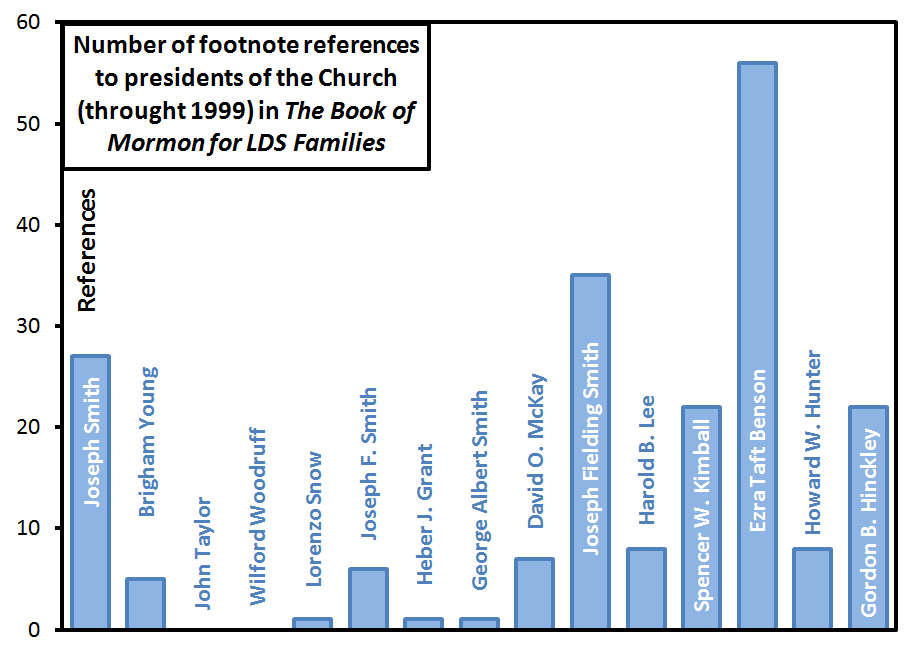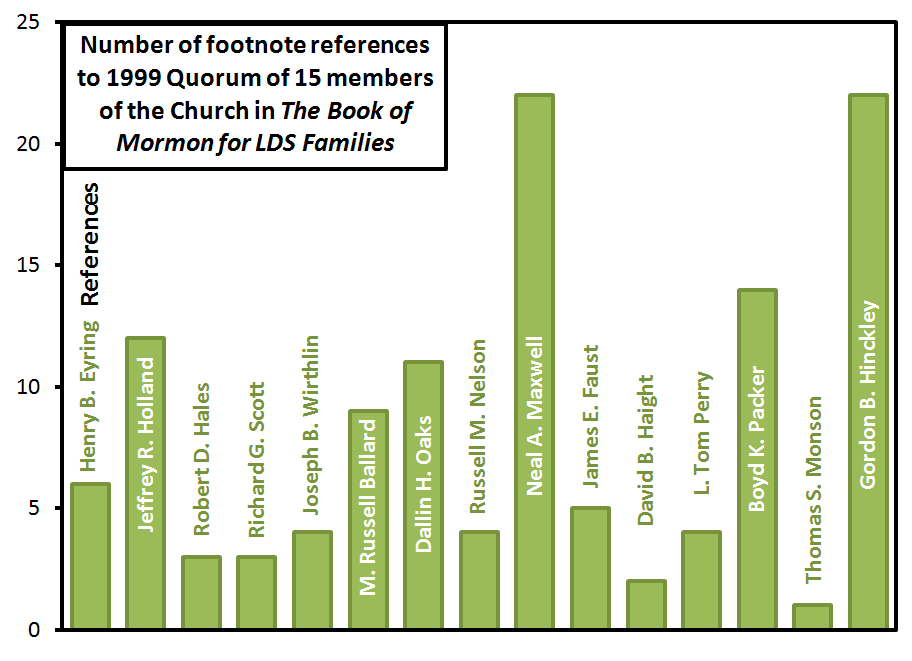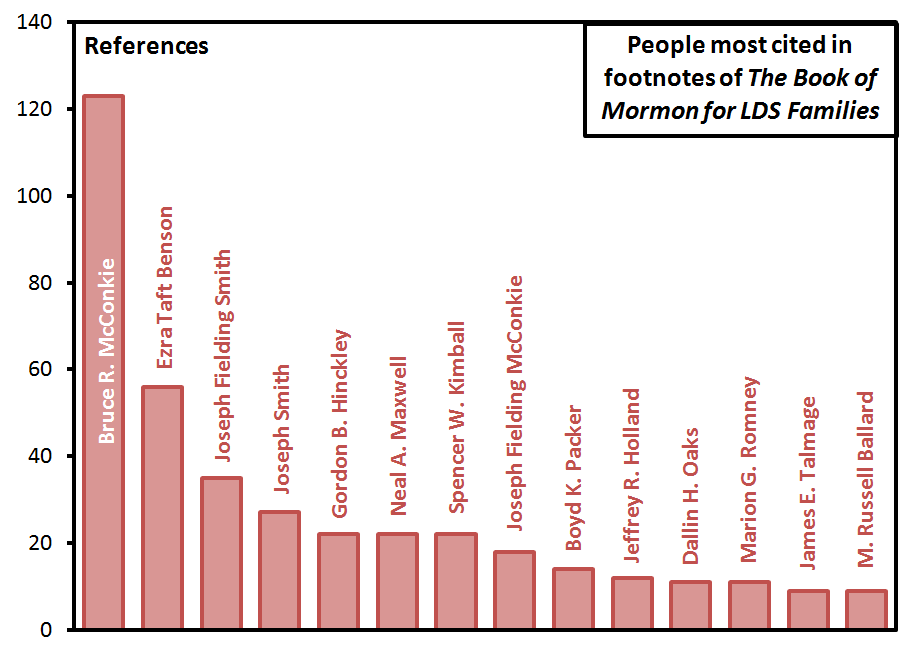A couple of years ago, a friend gave my family a copy of Bookcraft’s The Book of Mormon for Latter-day Saint Families. My wife and I have been reading it with our kids. It has a lot of useful features that make it more appealing for kids: it’s an oversized book with pictures, maps, subheadings within chapters, big print, and definitions of difficult words in the footnotes.
But the footnotes aren’t limited to definitions. There are also broader explanations, discussion questions, and quotes from General Authorities. Most of these and unobjectionable, but a few are a bit bizarre. For example, here’s a footnote to 1 Nephi 5:11, where Lehi looks at the brass plates and sees “that they did contain the five books of Moses”:
This reference in the Book of Mormon adds support to the knowledge that Moses wrote the first five books of the Bible: Genesis, Exodus, Leviticus, Numbers, and Deuteronomy.
I guess I would have thought that Joseph Smith was just applying the commonly understood term “five book of Moses” when he translated this, rather than suggesting that they necessarily must have been written by Moses himself.
Another fun footnote is a discussion question that accompanies 2 Nephi 2:25:
How has Adam’s decision to eat the forbidden fruit blessed you?
Really? Adam’s decision? And here I thought that one positive of Mormonism’s view of women was that we at least acknowledge Eve’s decision to eat the fruit as a good one. But now that it’s good, it’s attributed to Adam? Not even to both of them? This footnote actually falls in line with the consistent use of sexist language in the footnotes, which seems all the more odd given how many general authorities now make it a point to make gender inclusive generalizations when quoting from the scriptures.
Here’s an explanation for the phrase “a virgin shall conceive” in 2 Nephi 17:14 (quoting Isaiah 7:14):
A young woman who is pure, chaste, and who has not had intimate relations with a mortal man will become pregnant.
I take it from that “mortal man” caveat that the editors of this book want to leave the door open for the “God had sex with Mary” theory of Jesus’s conception. (To be fair, the similar footnote to the word “virgin” in Alma 7:10 omits the word “mortal.”)
These footnotes, at least when they’re odd, seem to have literalist (dare I say a fundamentalist?) slant. I wanted to look at them more completely, though, to see if there was actually any evidence of this in the entire set of them rather than a few chosen strange ones. Now if I were good with texts, I would have tried to answer this question by doing some kind of content analysis. But I’m not good with texts; I’m good with counting.
So to answer my question, rather than looking at the content of the footnotes, I decided to look at who was quoted in the footnotes. It would clearly signal different editorial slants if, say, the footnotes quoted Hugh B. Brown a lot versus if they quoted Joseph Fielding Smith a lot.
I looked through all the footnotes in the book and counted up who got quoted or referred to in each. Of course many footnotes were simple explanations and didn’t quote anyone. I ignored them in the count. I also ignored references to other scriptures, counting only quotes of other people or references to sources outside the scriptures. I counted 714 total references.
Who was quoted most among Church Presidents?
 Ezra Taft Benson was the clear favorite among Church Presidents.
Ezra Taft Benson was the clear favorite among Church Presidents.
Who was quoted most among members of the First Presidency and Quorum of the Twelve (as of 1999, when the book was published)?
 Notice that the scale of the vertical axis has changed, as the then current members with the most footnote references had only 22, versus 56 for Ezra Taft Benson. I don’t see a clear pattern here. It’s not terribly surprising that the Church President at the time rated the most references among members of the 15, I guess.
Notice that the scale of the vertical axis has changed, as the then current members with the most footnote references had only 22, versus 56 for Ezra Taft Benson. I don’t see a clear pattern here. It’s not terribly surprising that the Church President at the time rated the most references among members of the 15, I guess.
So who was quoted most overall? (Again, watch for a change in the vertical axis.)
Bruce R. McConkie was quoted 123 times–over twice as often as the person quoted next most often–and more than the next three people combined. Joseph Fielding Smith, despite his brief tenure as President, took the #3 slot overall. Bruce R.’s son, Joseph Fielding McConkie, with 18 quotes, was the most often quoted non-General Authority. (Hugh Nibley was next with 8.) The results don’t all point in the same direction: Gordon B. Hinckley was quoted quite frequently, for example, and he definitely seemed to me to be less conservative than the McConkies and Smith. But on the whole, these results do suggest that the editors of The Book of Mormon for Latter-day Saint Families had preferences for Bruce R. McConkie’s (and Joseph Fielding Smith’s) definitive-sounding literalist interpretations of scripture.
(Oh, and in case you were curious, I found a grand total of one woman quoted in the footnotes. Aileen H. Clyde, former 2nd counselor in the Relief Society General Presidency, was quoted in a footnote to Mosiah 5:7 .)

Awesome, I am laying odds that this preference is derivative of the CES Manuals.
Thank you for the warning. I will NOT be buying this book for my family.
Ziff, how very cool. It looks like Jos. Fielding McConkie was the ONLY non-GA (male) quoted. Is that right? Who put this volume together (any ties to the McConkies)? What was the quote by Aileen Clyde?
Oh, I see Hugh Nibley–any other non-GAs?
Thanks, Matt, Emily, and BiV.
BiV, unfortunately I don’t have the book with me, so I’m not sure who the editors are. Matt’s likely right that it’s some kind of CES connection.
There were actually a lot of other non-GAs cited, but typically only once or a couple of times. (Sorry it wasn’t clear–the last figure is only the most often cited people. The complete figure would be really long.) A non-LDS Bible Dictionary was cited a few times, and some books that sounded to me like they were written by BYU religion professors, for example. I guess Joseph Fielding McConkie actually falls in that category, doesn’t he? If I remember right, he taught religion at BYU.
The editor for the book was Tom Valletta. It looks like he is a former mission president, former CEO of a computer software company, and currently in charge of open-source programming for the church. So his team probably created the church’s new iPhone app.
The sources he cites are probably a consequence of when and where he spent growing up. But if you wanted to take this analysis further, you could go to scriptures.byu.edu, get a count for how many times each of the Brethren have cited the Book of Mormon in their conference talks, and then see whether President Benson’s numbers are higher simply because he talked so much about the Book of Mormon. You might also be able to measure the total number of published pages from each of the Brethren, and determine whether Elder Maxwell’s and McConkie’s numbers are higher because they were among the most prolific church leaders in this dispensation.
Very interesting, Ziff. We received a copy of this for our wedding, and have yet to even crack it open.
Thank you for pointing out that fallacy with “Adam’s decision.” That drives me up a wall. I hate hate hate when people refer to the “fall of Adam” as if Eve wasn’t even there. Huge pet peeve.
Great fun, as usual.
I know Tom a little bit. He is both a great guy and a fine gospel scholar. He is also a CES guy, so the CES influence is indeed going to be strong in a work such as this.
In my Documentary Hypothesis article, I argued against the proposition that that allusion to the “five books of Moses” necessitated the meaning required by the footnote.
Thanks so much for pointing this out!
“Adam’s decision”? You mean the decision to do the same thing as Eve already decided to do? My word.
Emily (#2),
You don’t HAVE to read all the footnotes, etc. to the family when reading it out loud. This has been the most useful thing I have found to study in our little family, and I feely skip a lot of the footnotes.
Even if the “five” in the “five books of Moses” isn’t Joseph Smith’s gloss, but Nephi’s statement, it still doesn’t establish anything about authorship, only that by 586 when Lehi left, there was a tradition of such.
RE- Adam’s Decision.
Actually, Eve and Adam decided to partake of the fruit for very different reasons, if you accept the most modern account appearing in the Temple. Eve partook to gain knowledge and understanding, and Adam partook so that he could stay with Eve and thus fulfill the command to “multiply and replenish”. This ties directly to the scripture that “Adam fell, that men might be…”
Just Saying…
Ziff, fascinating as always!
I was surprised at how little Gordon B was quoted in comparison to ETB. I wonder if this was a long project in the works, work being done prior to President Hinckley’s call, and that is also reflected on how frequently ETB was quoted… how long do projects like this take?
I don’t have a copy of this, but several family members do and they all love it. (Of course none of my family members would be particularly concerned with the Adam’s Fall debate, so I’m not sure their recommendation would mean much to the ZD crowd).
Does anyone have the book for Aileen Clyde’s quote?
Oh, sorry Enna–thanks for reminding me I hadn’t answered BiV. Here’s the footnote on Mosiah 5:7 from Alieen Clyde. (The first part isn’t a quote from her; her quote starts at the quotation mark.)
.
I have mostly bad things to say about this book, so I’m going to plead the Thumper and be quiet this time around.
Oh, come on, Th! Whatever happened to “if you don’t have anything nice to say about any [books] come and [blog] by me”?
I was just about to post what Matt W posted in #11.
Did all the quotations date from a time when the person held the office indicated?
Sorry, Left Field–that’s a good question but I didn’t record that. For example, I suspect most of the Joseph Fielding Smith quotes came from before when he was President.
Hmm, my comment disappeared.
The Book of Mormon doesn’t prove Mosaic authorship of the Pentateuch; only that by Nephi’s day such a tradition existed.
Kaboom. And then your awesome Ziff-ness kicked in again.
17, The Benson quotes would almost certainly come mostly from before his presidency.
Do I now have two comments in the spam queue?
Sorry, Ben. I’ve liberated them. I’m not sure why they got caught.
I have the OT for LDS families. I like it for the illustrations, but the footnotes have the same problems you have noted in the BoM version. I get the impression the editors are not scholars.
Very interesting. I would echo the point Sterling raises. For example, what are the chances of finding exposition on some point of relatively obscure doctrine by Elder Wirthlin/Haight vs. Maxwell/McConkie?
My guess is that this probably has as much to do with the volume and accessibility of Book of Mormon commentary at least as much as the degree of editorial bias.
It would be interesting to see what another attempt could produce if it conscientiously pursued a broader range of sources…
.
My main complaint is that some big-deal LDS designers wanted to make a beautiful copy of the BofM that they could give to their snobby New York friends. The imagined a version that would be a few hundred dollars, a midrange version, a 20-buck version. All lovely and well designed, but some lusher than others.
Though the text is in the public domain, they decided they wanted the Church’s blessing and the Church asked them not to because there should not be a version of the Book of Mormon that could lead to class distinctions. So they didn’t proceed with the project.
Then this version under discussion came out, which was certainly more expensive than many members could legitimately pay for and that (even worse?) was ugly. And sure enough if became a minor status symbol in certain circles. And there still isn’t a version of the book that snotty artists can accept from an LDS friend without immediately giving it to Goodwill. There isn’t a version of the BofM suitable for display.
This book represents all the evil feared in a fancy edition and none of the good.
Plus, as you pointed out, its footnotes are obnoxious.
I just found a great use for this heavy book.
I’m working on a jigsaw puzzle, and I have to keep it safe from my kitties who desire to wreak havoc on it. So I cover it up with a big piece of cardboard. Then I have to weigh down the cardboard to it doesn’t get all slid around. A la, the book.
I’m really glad we have it. 🙂
Regarding Matt’s comment in #1. Though not as statistically sophiscated as Ziff’s analysis here I wrote a post at MM sometime ago on the new CES BoM Institute manual looking at quotations.
Thanks for the pointer, Aaron. Interesting work! It does sound like the citation preferences are similar, perhaps driven by, as Sterling and James suggest, simply the volume of writing different GAs have done.
I had the same idea in regards to the NT institute manual awhile back, so I did a the same analysis. Similar results-no suprise. Even worse actually. Out of 710 quotes, almost 40.8% were from JFS and BRM, with BRM at 32%. It would be cool to see a comparative study of quote attribution in official publications for different phases of church history.
Thanks for the data, Hemi. That sounds like a lot more work, but equally disappointing, as you note.
Fascinating, Ziff! We have this book and use it for scripture study with our family every night. We like the way the chapters are subdivided so we can read in smaller chunks but feel like we are still accomplishing something. I don’t know that I’ve ever actually read a footnote, but now I am interested . . .
Ziff, do you think that the people who are cited the most often could be due to the age of the person who put together the footnotes and what comments he/she has been exposed to during their lifetime?
Yeah, that seems entirely reasonable, Stephanie. I think a couple of other people suggested above that it was related to how much writing the GAs being cited had done–those who wrote a lot got cited a lot. Your suggestion is probably related: those who wrote a lot were read (or heard of) a lot by the editors of this book, so they were cited a lot.